When you picture bringing a dog home, you imagine belly rubs, long walks, and a bond that lasts a lifetime—not endless vet visits or constant health scares. But here’s the truth most new pet parents don’t realize: some of the world’s most beloved breeds come with built-in health challenges, shaped by genetics, selective breeding, and sometimes, simple bad luck.
From adorable flat-faced pups who struggle to breathe on hot days to large majestic breeds prone to joint issues, these dogs need a little extra care—and a lot of love. That doesn’t mean they can’t live happy, fulfilling lives; it just means understanding their risks helps you be a better, more prepared pet parent.
Whether you’re choosing your first furry companion or already have one snoozing beside you, this guide will walk you through the most common unhealthy dog breeds, what makes them vulnerable, and how you can help them live their healthiest, happiest life possible.
Common Unhealthy Dog Breeds
1. English Bulldog

Also known as the British Bulldog, the English Bulldog is instantly recognizable by its stocky build, loose skin, and distinct pushed-in nose.
Hill’s Pet describes the English Bulldog as a sturdy, muscular dog whose signature waddle reflects its strength, balance, and vitality.
According to a Quora response by Marie, who lives in Northern England, Bulldogs are her favorite breed and the only one she would ever adopt — though she would never buy one from a breeder.
Sadly, she believes the breed should be allowed to die out due to the severe health problems caused by human-driven breeding. Bulldogs were originally bred for bull-baiting, with flatter faces and stockier builds to grip bulls, but these traits have led to serious health issues.
Their shortened skulls (brachycephalic) cause breathing difficulties, heat intolerance, and overcrowded teeth, while their skin folds can easily become infected. Because of these ongoing issues, Marie concludes that both English and French Bulldogs, though deeply loved, will always be unhealthy breeds.
As discussed, one of the most pressing concerns for English Bulldogs is brachycephalic syndrome. In addition to skeletal issues, English Bulldogs frequently struggle with skin infections due to deep folds that trap moisture and bacteria.
Regular cleaning is crucial to prevent irritation and discomfort. Eye problems like cherry eye and entropion are also common, often requiring surgical intervention to restore comfort and vision.
Their limited stamina and predisposition to obesity demand a balanced diet and moderate exercise routine. Because of these numerous inherited challenges, the English Bulldog has a lifespan of about 8–10 years, notably shorter than many medium-sized breeds — a testament to the health risks tied to its unique physique.
2. Pug

The Pug, often called the Mopshond or Carlin, is a small, affectionate breed with a distinct wrinkled face, short muzzle, and curled tail. Originating in China and adored by European nobility, Pugs are celebrated for their charming personalities and sociable nature.
However, their iconic flat face—one of their most recognizable traits—also makes them vulnerable to a range of health problems that prospective owners should carefully consider. PetMD notes that Pugs were once cherished by royalty across the globe and remain a highly popular breed today.
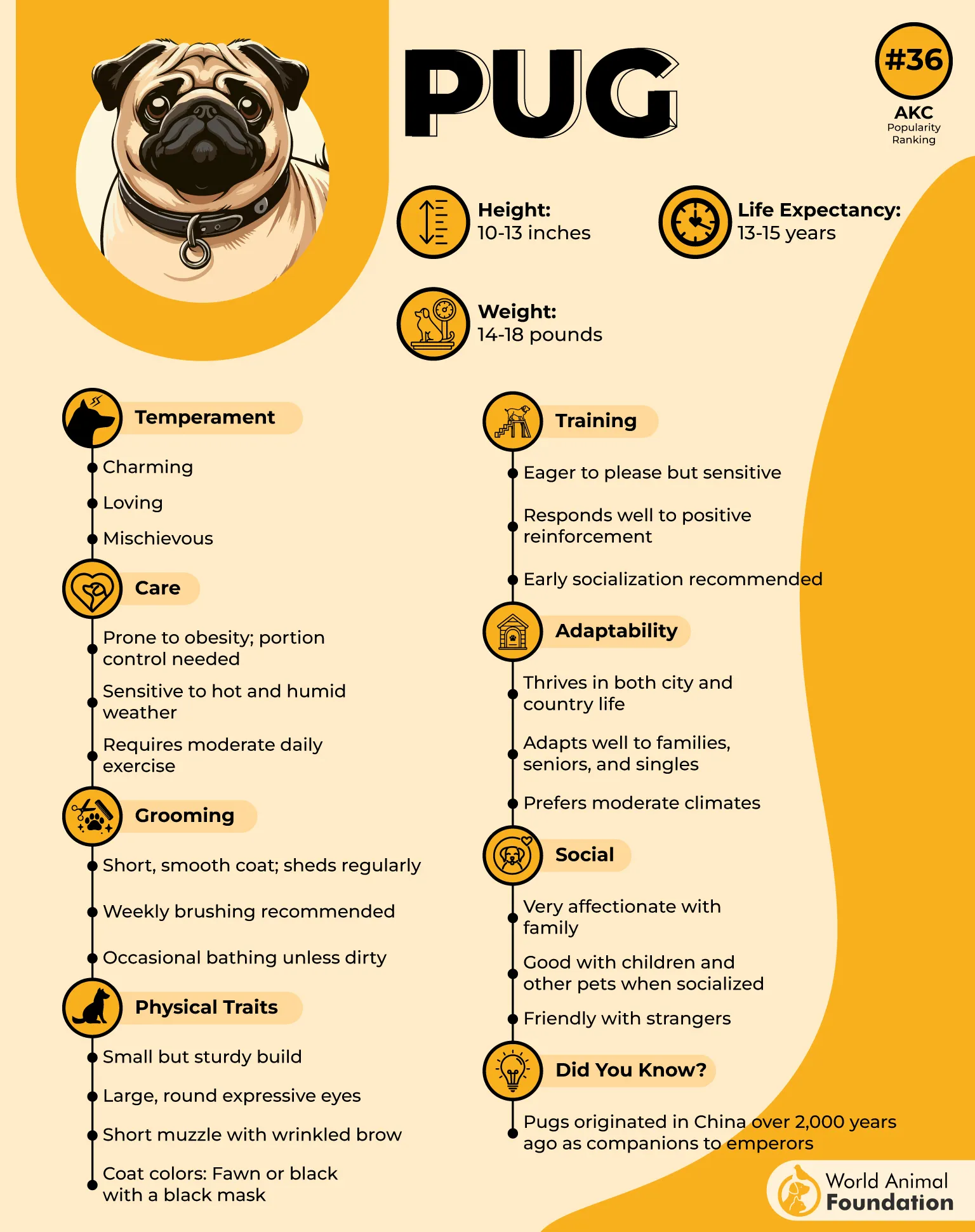
One of the most significant health concerns in Pugs is Brachycephalic Obstructive Airway Syndrome (BOAS). This condition leads to labored breathing and difficulty in regulating body temperature. In severe cases, it can result in respiratory distress, especially during hot weather or physical activity.
Pugs are also prone to eye-related issues, including corneal ulcers, dry eye, and progressive retinal atrophy (PRA). Their large, prominent eyes are easily injured, making regular veterinary care essential for early detection and management of ocular conditions.
Additionally, obesity is a common problem among Pugs due to their love of food and limited exercise tolerance. Royal Veterinary College revealed that Pugs are 54 times more likely to develop BOAS compared to other breeds.
3. French Bulldog

Also known as the “Frenchie,” the French Bulldog is a small, muscular breed distinguished by its bat-like ears, short muzzle, and affectionate personality. WebMD explains that French Bulldogs were bred to be companions rather than workers, yet they still have a playful, fun-loving nature.
Their playful charm and adaptability make them popular city companions, but beneath their adorable looks lies a breed prone to several serious health concerns.
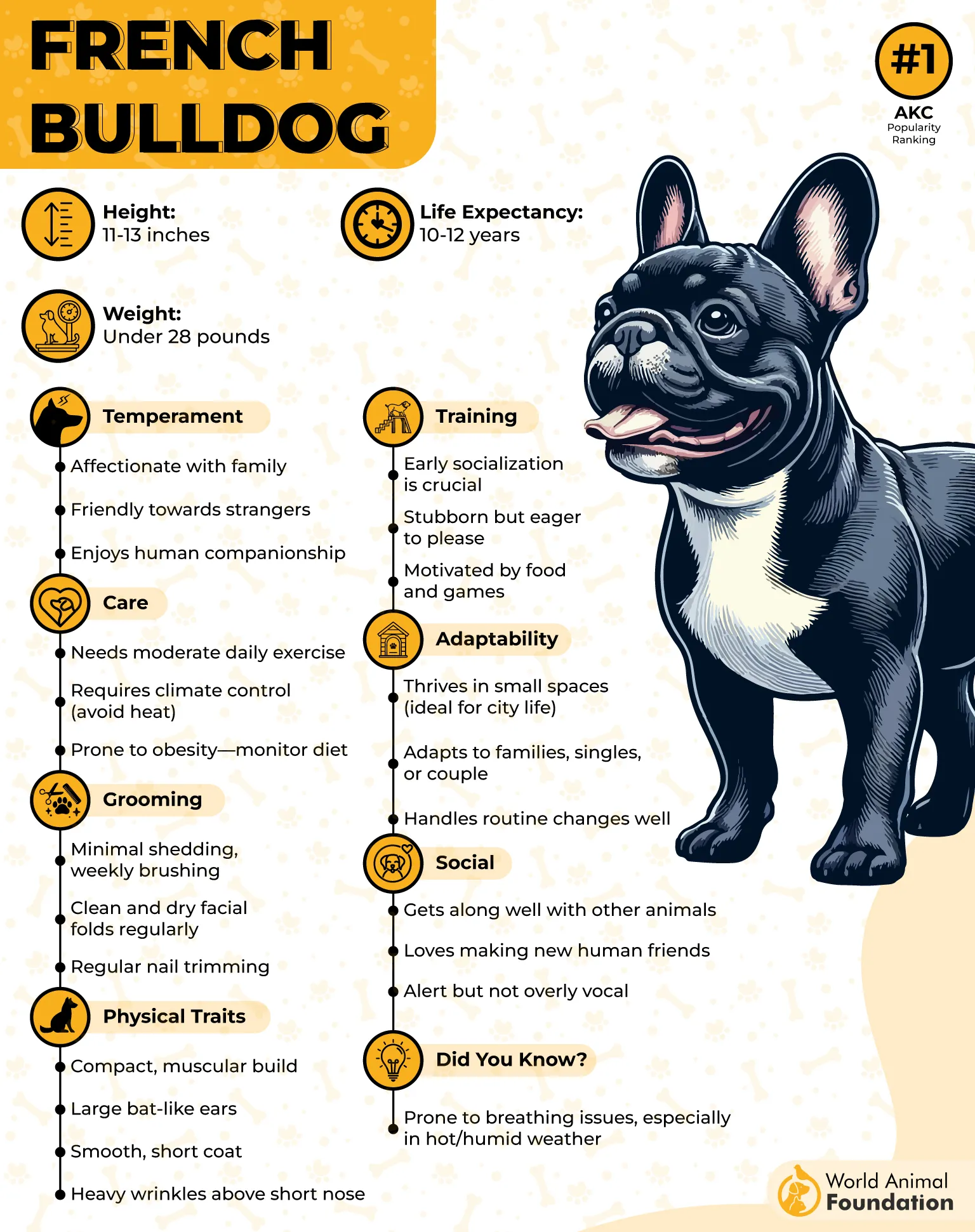
Their shortened skulls compress soft tissues within the airway, leading to noisy breathing, wheezing, and exercise intolerance. Additionally, their narrow nostrils, or stenotic nares, further restrict airflow.
Combined with an elongated soft palate, this can cause chronic snoring, difficulty during physical activity. Some dogs may require surgery to improve breathing and quality of life.
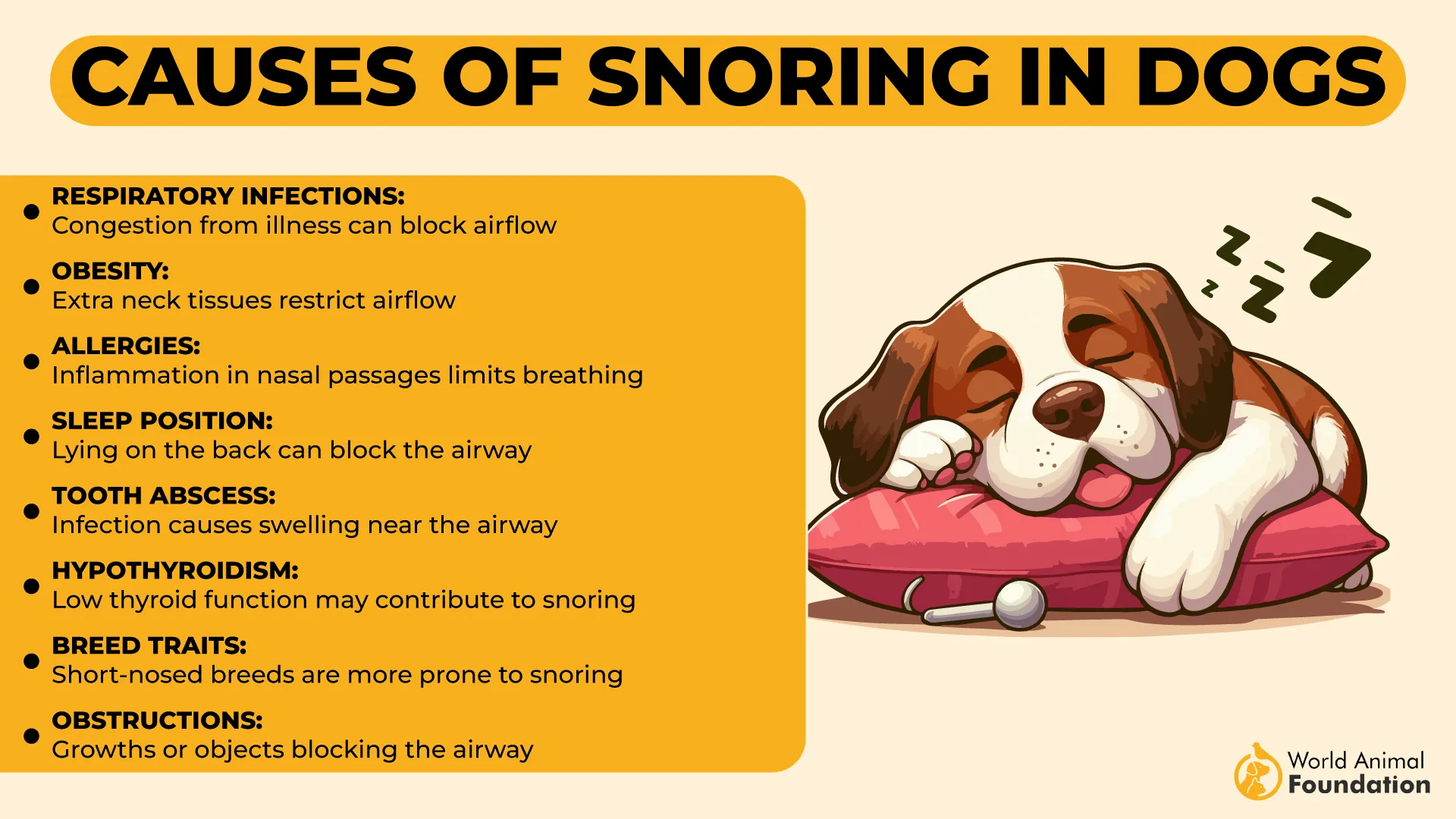
Because of their airway structure, French Bulldogs may experience complications under anesthesia, making surgical care more challenging. Regular veterinary monitoring, weight management, and avoiding strenuous exercise can help minimize risks.
Fun Fact: Despite their health challenges, French Bulldogs remain one of the most popular companion breeds in the U.S., beloved for their affectionate, clownish nature.
4. German Shepherd

Also known as the Alsatian, the German Shepherd is a noble and intelligent breed admired for its courage, loyalty, and versatility.
According to Tanya on Quora, a breeder with over 20 years of experience, modern German Shepherds have been harmed by show breeding, leading to sloped backs, weak hindquarters, and narrow chests. These traits make them prone to bloat (GDV), hip dysplasia, and degenerative myelopathy (DM).
She recommends choosing old-fashioned, straight-backed Shepherds from reputable breeders who prioritize health testing and sound structure over show appearance.
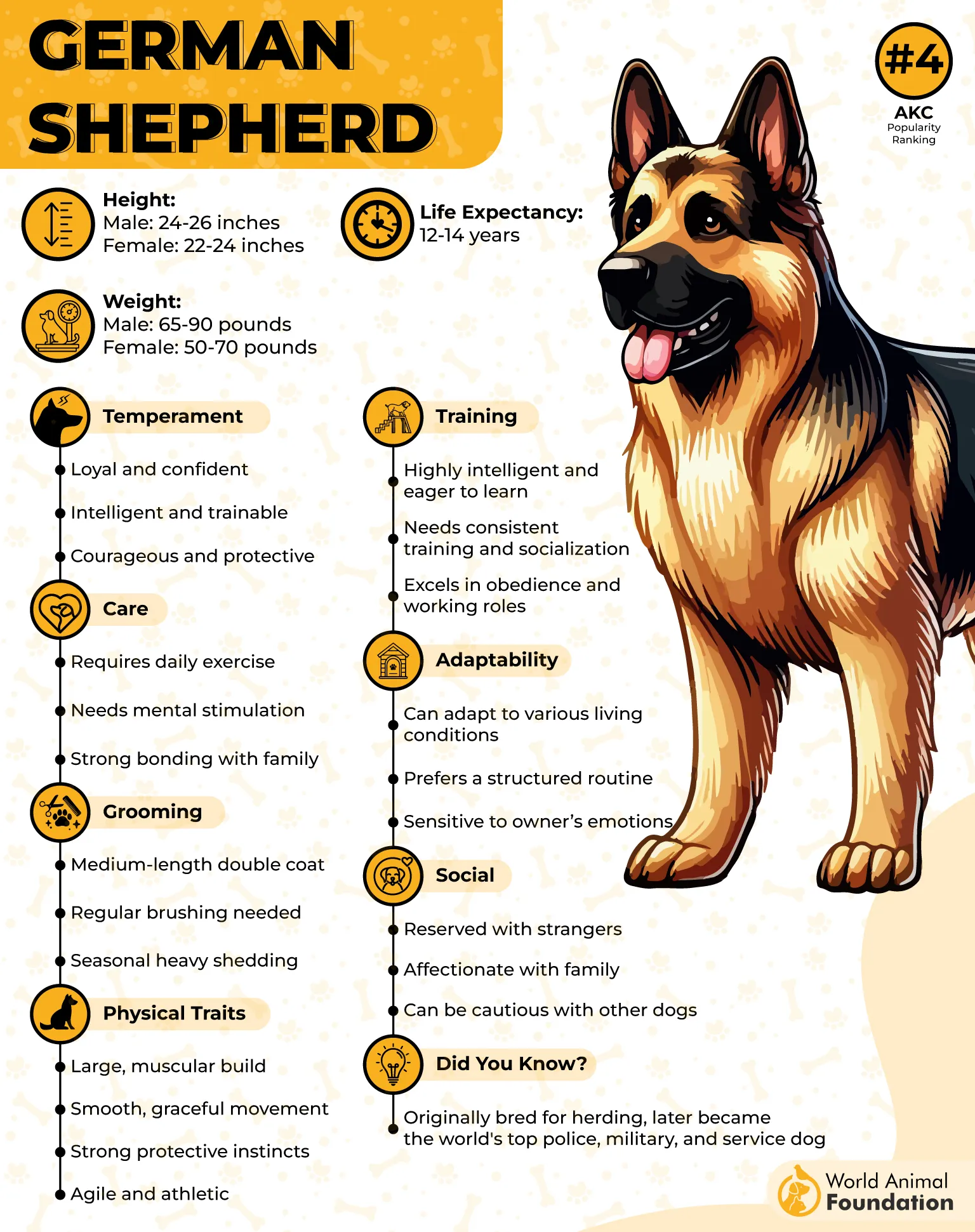
Despite their strength, German Shepherds are genetically prone to musculoskeletal disorders, particularly hip and elbow dysplasia. These painful joint conditions can impair mobility and often worsen with age, emphasizing the need for early detection, balanced nutrition, and regular exercise.
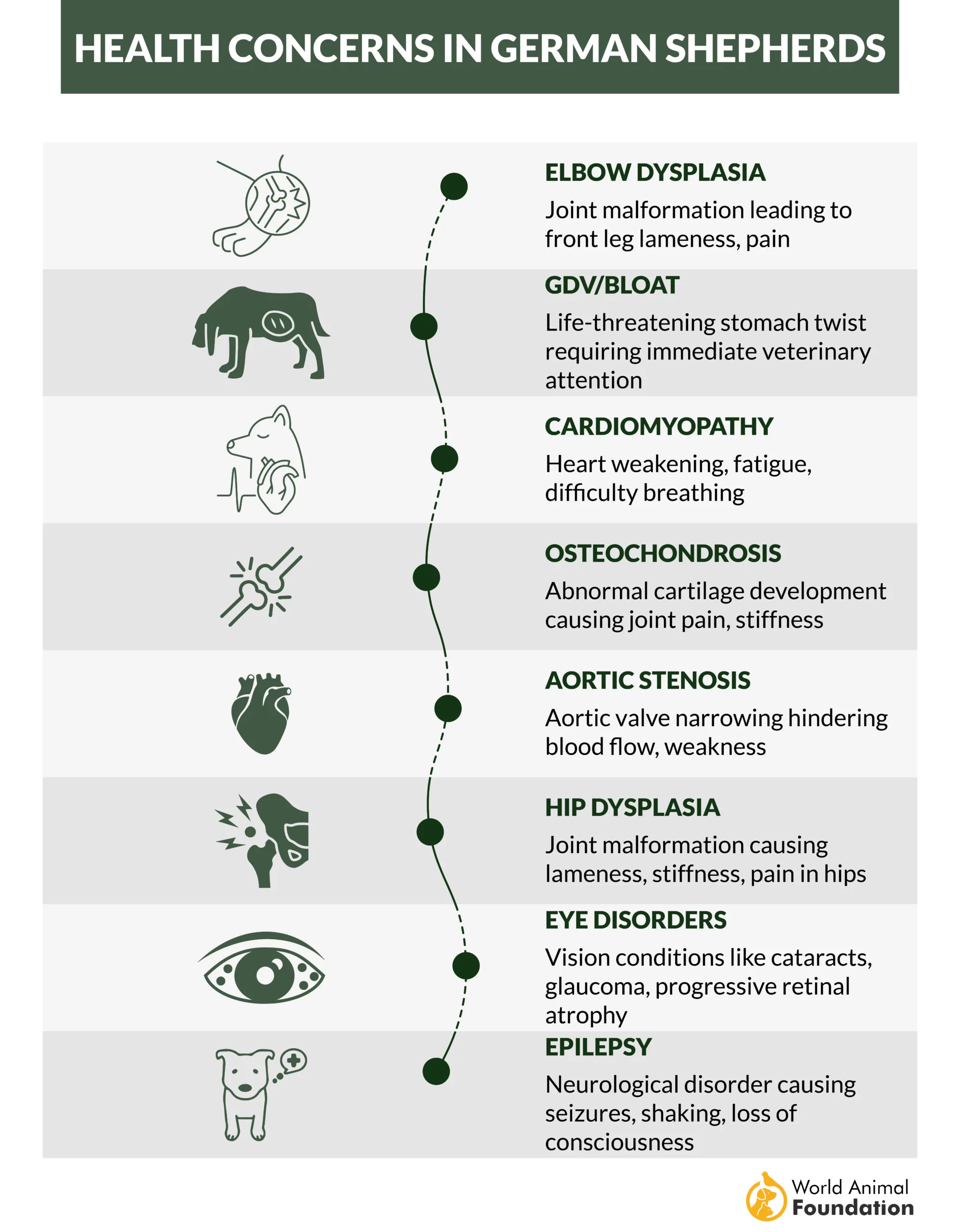
Their relatively short lifespan, averaging between 7 and 10 years, makes them one of the larger breeds with briefer longevity. Obesity can further strain their joints and organs, increasing risks of arthritis, heart disease, and other chronic conditions if not managed properly.
In addition to joint issues, German Shepherds may face an elevated risk of cancer compared to smaller breeds. Routine veterinary care, weight control, and dental hygiene are vital for prolonging their lives.
Fun fact: German Shepherds remain one of the most popular working breeds worldwide, valued for their intelligence and unwavering loyalty.
5. Dachshund
The Dachshund, also fondly known as the Wiener Dog or Sausage Dog, is instantly recognizable for its long body and short legs—a result of breeding for dwarfism. Originally developed for hunting burrowing animals, their distinct physique makes them both charming and vulnerable to certain health conditions.
Due to their elongated spine, Dachshunds are particularly prone to Intervertebral Disc Disease (IVDD), a painful condition that can lead to mobility issues or even paralysis. This risk is heightened by activities like jumping off furniture or climbing stairs, which put undue strain on their backs.
Owners are encouraged to minimize these actions by using ramps or assisting their dogs manually.
Weight management is another crucial aspect of care. Extra pounds can worsen spinal stress, increasing the likelihood of back injuries. A balanced diet tailored to their life stage—guided by a veterinarian—can help maintain an ideal physique and reduce complications.
Grooming needs vary by coat type: smooth coats require minimal upkeep, while long and wire-haired Dachshunds need frequent brushing to prevent matting. Regular dental care and nail trimming are essential, as neglected grooming can lead to infections or discomfort.
Fun fact: Dachshunds were bred in Germany over 300 years ago to hunt badgers!
6. Cavalier King Charles Spaniel
Also known as the Cavalier or Toy Spaniel, the Cavalier King Charles Spaniel is admired for its expressive eyes, silky coat, and gentle nature. Despite their charm, Cavaliers are vulnerable to several hereditary health issues that require attentive care.
Among their most concerning conditions is mitral valve disease, a degenerative heart disorder that can lead to heart murmurs and eventual heart failure if unmanaged.
This breed also faces risks of syringomyelia, a neurological disorder causing neck and head pain, as well as chronic ear infections due to their long, drooping ears.
When it comes to joint health, Cavaliers are among the smaller breeds prone to canine hip dysplasia, an abnormal formation of the hip joint. This condition can lead to stiffness, lameness, and painful movement, particularly as the dog ages. Early screening and weight management are key to reducing its impact.
While genetics play a major role in hip dysplasia, factors like overfeeding and rapid puppy growth can worsen symptoms.
Fact: Norway has banned breeding Cavalier King Charles Spaniels due to severe hereditary health concerns, emphasizing the need for responsible breeding practices.
7. Rottweiler
Also known as the Rottie, the Rottweiler is a powerful, muscular breed originally bred as a drover dog for Roman legions and later standardized in Germany in the 19th century.
According to a response on Quora, a dog’s behavior largely depends on the owner, not just the breed. Some dogs — especially powerful or headstrong breeds like Rottweilers can develop stubborn or aggressive traits if they feel they must lead the pack. With consistent, confident, and loving ownership, however, they can become loyal, intelligent, and affectionate companions.
The writer shared their experience rescuing a Rottweiler/German Shepherd mix named Cherokee — often labeled a “bad” mix. Despite her reputation, Cherokee proved to be incredibly loyal, smart, and well-behaved, changing many people’s perceptions.
This story highlights that even breeds often seen as “difficult” or “unhealthy” — whether due to temperament or physical traits — can thrive when raised by responsible, attentive owners who meet their needs and train with patience and understanding.
Rottweilers are prone to several genetic conditions, including hip and elbow dysplasia, which can severely impact mobility. They also face endocrine and blood disorders such as hypothyroidism and Von Willebrand’s disease, making regular health screenings essential for early detection.
Among their most concerning issues are heart diseases like aortic stenosis, a narrowing of the aorta that restricts blood flow, and dilated cardiomyopathy, which weakens the heart’s ability to pump effectively. These conditions often develop silently and may only show symptoms in advanced stages.
Routine veterinary checkups are crucial for monitoring cardiac health, particularly in large breeds like Rottweilers. A balanced diet, consistent exercise, and avoiding secondhand smoke can all contribute to a healthier heart.
Fact: Rottweilers typically live 8–10 years—shorter than many breeds—due to their size and predisposition to serious health issues.
Conclusion
Caring for dogs means more than love and companionship—it requires awareness of their unique vulnerabilities.
Even many popular dog breeds, including Golden Retrievers, Bernese Mountain Dogs, Shih Tzus, and Boston Terriers, face several health challenges ranging from joint disorders to breathing problems and heart disease.
Recognizing these common health concerns early allows pet parents to take preventive action. Maintaining a healthy weight, scheduling routine exams, and securing pet insurance can significantly improve your dog’s quality of life and help manage unexpected medical costs.
Even the most unhealthy dog breeds can thrive with proper veterinary care, balanced nutrition, and attention to exercise.
Whether you share your home with an energetic breed or a calm companion, proactive management guided by veterinary medicine ensures a longer, healthier life.
Understanding the risks and needs of each breed empowers owners to make informed decisions, fostering happier, healthier relationships with their beloved pets.


